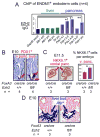Chromatin "prepattern" and histone modifiers in a fate choice for liver and pancreas
- PMID: 21596989
- PMCID: PMC3128430
- DOI: 10.1126/science.1202845
Chromatin "prepattern" and histone modifiers in a fate choice for liver and pancreas
Abstract
Transcriptionally silent genes can be marked by histone modifications and regulatory proteins that indicate the genes' potential to be activated. Such marks have been identified in pluripotent cells, but it is unknown how such marks occur in descendant, multipotent embryonic cells that have restricted cell fate choices. We isolated mouse embryonic endoderm cells and assessed histone modifications at regulatory elements of silent genes that are activated upon liver or pancreas fate choices. We found that the liver and pancreas elements have distinct chromatin patterns. Furthermore, the histone acetyltransferase P300, recruited via bone morphogenetic protein signaling, and the histone methyltransferase Ezh2 have modulatory roles in the fate choice. These studies reveal a functional "prepattern" of chromatin states within multipotent progenitors and potential targets to modulate cell fate induction.
Figures




Similar articles
-
High histone acetylation and decreased polycomb repressive complex 2 member levels regulate gene specific transcriptional changes during early embryonic stem cell differentiation induced by retinoic acid.Stem Cells. 2007 Sep;25(9):2191-9. doi: 10.1634/stemcells.2007-0203. Epub 2007 May 24. Stem Cells. 2007. PMID: 17525233
-
The histone methyltransferase Setd7 promotes pancreatic progenitor identity.Development. 2016 Oct 1;143(19):3573-3581. doi: 10.1242/dev.136226. Epub 2016 Aug 30. Development. 2016. PMID: 27578787
-
Pioneer factors, genetic competence, and inductive signaling: programming liver and pancreas progenitors from the endoderm.Cold Spring Harb Symp Quant Biol. 2008;73:119-26. doi: 10.1101/sqb.2008.73.040. Epub 2008 Nov 21. Cold Spring Harb Symp Quant Biol. 2008. PMID: 19028990 Free PMC article. Review.
-
Chromatin dynamics and the role of G9a in gene regulation and enhancer silencing during early mouse development.Elife. 2015 Nov 9;4:e09571. doi: 10.7554/eLife.09571. Elife. 2015. PMID: 26551560 Free PMC article.
-
Chromatin "pre-pattern" and epigenetic modulation in the cell fate choice of liver over pancreas in the endoderm.Nucleus. 2012 Mar 1;3(2):150-4. doi: 10.4161/nucl.19321. Epub 2012 Mar 1. Nucleus. 2012. PMID: 22555599 Free PMC article. Review.
Cited by
-
Cellular and molecular basis of liver development.Compr Physiol. 2013 Apr;3(2):799-815. doi: 10.1002/cphy.c120022. Compr Physiol. 2013. PMID: 23720330 Free PMC article. Review.
-
The Transcriptome and Epigenome Reveal Novel Changes in Transcription Regulation During Pancreatic Rat Islet Maturation.Endocrinology. 2021 Nov 1;162(11):bqab181. doi: 10.1210/endocr/bqab181. Endocrinology. 2021. PMID: 34467975 Free PMC article.
-
Stepwise reprogramming of liver cells to a pancreas progenitor state by the transcriptional regulator Tgif2.Nat Commun. 2017 Feb 13;8:14127. doi: 10.1038/ncomms14127. Nat Commun. 2017. PMID: 28193997 Free PMC article.
-
Temporal Control of Mammalian Cortical Neurogenesis by m6A Methylation.Cell. 2017 Nov 2;171(4):877-889.e17. doi: 10.1016/j.cell.2017.09.003. Epub 2017 Sep 28. Cell. 2017. PMID: 28965759 Free PMC article.
-
Dynamic regulation of EZH2 from HPSc to hepatocyte-like cell fate.PLoS One. 2017 Nov 1;12(11):e0186884. doi: 10.1371/journal.pone.0186884. eCollection 2017. PLoS One. 2017. PMID: 29091973 Free PMC article.
References
Publication types
MeSH terms
Substances
Grants and funding
LinkOut - more resources
Full Text Sources
Other Literature Sources
Molecular Biology Databases
Miscellaneous

